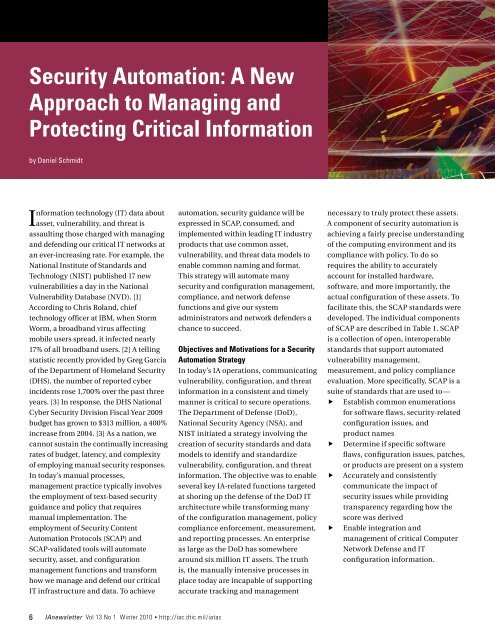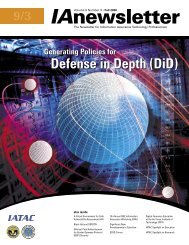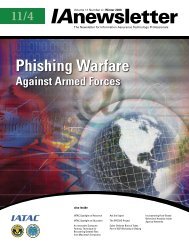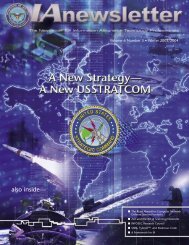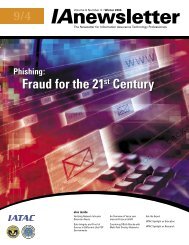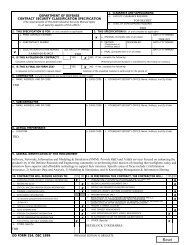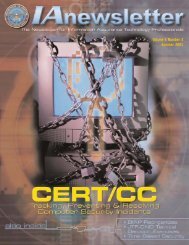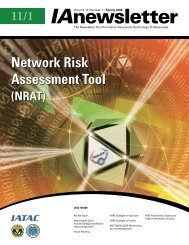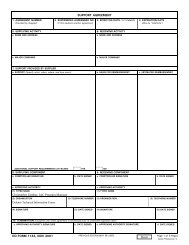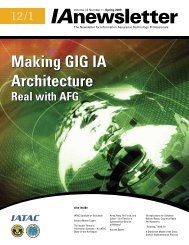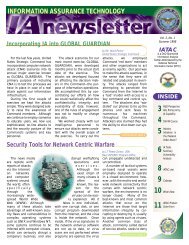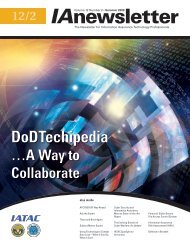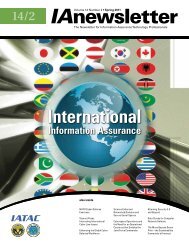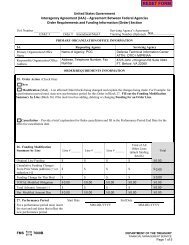Security Automation - IAC - Defense Technical Information Center
Security Automation - IAC - Defense Technical Information Center
Security Automation - IAC - Defense Technical Information Center
Create successful ePaper yourself
Turn your PDF publications into a flip-book with our unique Google optimized e-Paper software.
<strong>Security</strong> <strong>Automation</strong>: A New<br />
Approach to Managing and<br />
Protecting Critical <strong>Information</strong><br />
by Daniel Schmidt<br />
<strong>Information</strong> technology (IT) data about<br />
asset, vulnerability, and threat is<br />
assaulting those charged with managing<br />
and defending our critical IT networks at<br />
an ever-increasing rate. For example, the<br />
National Institute of Standards and<br />
Technology (NIST) published 17 new<br />
vulnerabilities a day in the National<br />
Vulnerability Database (NVD). [1]<br />
According to Chris Roland, chief<br />
technology officer at IBM, when Storm<br />
Worm, a broadband virus affecting<br />
mobile users spread, it infected nearly<br />
17% of all broadband users. [2] A telling<br />
statistic recently provided by Greg Garcia<br />
of the Department of Homeland <strong>Security</strong><br />
(DHS), the number of reported cyber<br />
incidents rose 1,700% over the past three<br />
years. [3] In response, the DHS National<br />
Cyber <strong>Security</strong> Division Fiscal Year 2009<br />
budget has grown to $313 million, a 400%<br />
increase from 2004. [3] As a nation, we<br />
cannot sustain the continually increasing<br />
rates of budget, latency, and complexity<br />
of employing manual security responses.<br />
In today’s manual processes,<br />
management practice typically involves<br />
the employment of text-based security<br />
guidance and policy that requires<br />
manual implementation. The<br />
employment of <strong>Security</strong> Content<br />
<strong>Automation</strong> Protocols (SCAP) and<br />
SCAP-validated tools will automate<br />
security, asset, and configuration<br />
management functions and transform<br />
how we manage and defend our critical<br />
IT infrastructure and data. To achieve<br />
automation, security guidance will be<br />
expressed in SCAP, consumed, and<br />
implemented within leading IT industry<br />
products that use common asset,<br />
vulnerability, and threat data models to<br />
enable common naming and format.<br />
This strategy will automate many<br />
security and configuration management,<br />
compliance, and network defense<br />
functions and give our system<br />
administrators and network defenders a<br />
chance to succeed.<br />
Objectives and Motivations for a <strong>Security</strong><br />
<strong>Automation</strong> Strategy<br />
In today’s IA operations, communicating<br />
vulnerability, configuration, and threat<br />
information in a consistent and timely<br />
manner is critical to secure operations.<br />
The Department of <strong>Defense</strong> (DoD),<br />
National <strong>Security</strong> Agency (NSA), and<br />
NIST initiated a strategy involving the<br />
creation of security standards and data<br />
models to identify and standardize<br />
vulnerability, configuration, and threat<br />
information. The objective was to enable<br />
several key IA-related functions targeted<br />
at shoring up the defense of the DoD IT<br />
architecture while transforming many<br />
of the configuration management, policy<br />
compliance enforcement, measurement,<br />
and reporting processes. An enterprise<br />
as large as the DoD has somewhere<br />
around six million IT assets. The truth<br />
is, the manually intensive processes in<br />
place today are incapable of supporting<br />
accurate tracking and management<br />
necessary to truly protect these assets.<br />
A component of security automation is<br />
achieving a fairly precise understanding<br />
of the computing environment and its<br />
compliance with policy. To do so<br />
requires the ability to accurately<br />
account for installed hardware,<br />
software, and more importantly, the<br />
actual configuration of these assets. To<br />
facilitate this, the SCAP standards were<br />
developed. The individual components<br />
of SCAP are described in Table 1. SCAP<br />
is a collection of open, interoperable<br />
standards that support automated<br />
vulnerability management,<br />
measurement, and policy compliance<br />
evaluation. More specifically, SCAP is a<br />
suite of standards that are used to—<br />
ff<br />
ff<br />
ff<br />
ff<br />
Establish common enumerations<br />
for software flaws, security-related<br />
configuration issues, and<br />
product names<br />
Determine if specific software<br />
flaws, configuration issues, patches,<br />
or products are present on a system<br />
Accurately and consistently<br />
communicate the impact of<br />
security issues while providing<br />
transparency regarding how the<br />
score was derived<br />
Enable integration and<br />
management of critical Computer<br />
Network <strong>Defense</strong> and IT<br />
configuration information.<br />
6 IAnewsletter Vol 13 No 1 Winter 2010 • http://iac.dtic.mil/iatac


